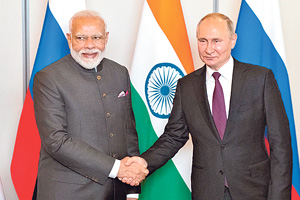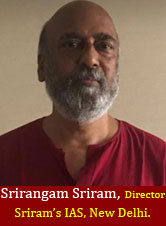India’s ‘Act Far East’ policy opens up a variety of opportunities for mutual benefit. Analyse the statement.
Sakshi Education
By Srirangam Sriram, Sriram's IAS, New Delhi.

What about the Geopolitics?
Geopolitically, India’s increased presence in the South China Sea agrees with India’s vision of a ‘Open, free and inclusive Indo – Pacific’ including freedom of navigation in maritime and air space.
India’s USD one billion line of credit enables India’s presence in the Russian far east which is in the vicinity of China’s immediate neighborhood.
Both the countries are committed to building an equal and indivisible security architecture in Asia and the Pacific region within the framework of the East Asia Summit and other regional platforms (Asean centrality). Russia’s Far East is located in the Pacific Ocean. India’s Indo-pacific strategy, which in Prime Minister Modi’s words is “inclusive” should reassure Russia though Russia is opposed to Indo- Pacific notion as such as it believes that it is an American ploy to contain China.
Russia wants to balance Chinese presence in the region.
Japan is also trying to improve its relations with Russia through investments in the Russian far east. Japanese Prime Minister attended this forum since its beginning.
What kind of Energy bond will the policy develop?
The energy complementarities between India and Russia are also impressive. India has to take its relation with Russia beyond defense. Energy is an attractive area of mutual interest. India’s hydrocarbon engagement through investments in Russia’s energy sector has been more than two decades old. In 2001, ONGC Videsh acquired a 20 per cent stake in Sakhalin-1 oil and gas field in Far East Russia. It further bought Imperial Energy a few years later and recently invested more. In 2018 Russian firm Rosneft has bought a majority stake in Essar Oil for USD 12.9 billion. With India embarking plans to move towards gas based economy gas utility GAIL has contracted 2.5 million tons per annum of LNG from Russia’s Gazprom for 20 years. Energy has become a key pillar in Indo–Russian ties. The labor scarce and resource rich region in Russia needs investments, trade, technology and connectivity. India can fill this void with its abundant labor surplus.

Eastern Economic Forum is an international forum held each year in Vladivostok, Russia, for the purpose of encouraging foreign investment in the Russian Far East and was established by President Vladimir Putin in 2015. Prime Minister Narendra Modi was the Chief Guest of the Fifth Eastern Economic Forum (EEF) in September 2019. PM Modi announced one billion dollar line of credit for the development of the resource-rich region. It was the launching of India’s look far east policy.
What's Russia's interest in it?
Russian President Vladimir Putin under his ‘Pivot to Asia’ is opening up the region to foreign investment. Russia is concerned about the Chinese intentions in the Far East. Russia fears the ‘demographic invasion’ from illegal influx of Chinese migrants in its far east. To offset the same, Russia wants other countries like Vietnam, Indonesia, Japan, South Korea and India to develop the region. New Delhi has responded to Moscow’s ‘Pivot to Asia Strategy’ by extending its ‘Act East Policy’ to ‘Act Far East policy’. Act Far-East Policy is the latest construct in India’s foreign policy, which already has such concepts as Act East Policy and the Indo-Pacific.
What's Russia's interest in it?
Russian President Vladimir Putin under his ‘Pivot to Asia’ is opening up the region to foreign investment. Russia is concerned about the Chinese intentions in the Far East. Russia fears the ‘demographic invasion’ from illegal influx of Chinese migrants in its far east. To offset the same, Russia wants other countries like Vietnam, Indonesia, Japan, South Korea and India to develop the region. New Delhi has responded to Moscow’s ‘Pivot to Asia Strategy’ by extending its ‘Act East Policy’ to ‘Act Far East policy’. Act Far-East Policy is the latest construct in India’s foreign policy, which already has such concepts as Act East Policy and the Indo-Pacific.
What is the Geo-economics of it?
The economic side of the act far east policy is
The economic side of the act far east policy is
- The proposed maritime route connecting Chennai with Vladivostok will help in transportation of maritime cargo by halving the time (24 days as compared to 40 days via Suez Route) as well as distance taken to reach Russia. It allows India an alternate route which India can utilize for its trade with Europe.
- The proposed route sea between Chennai and Vladivostok could open new opportunities for connectivity between the two major ports. It will help in improving bilateral trade from the current USD 11 billion to USD 30 billion by 2025.
- The ‘Act Far East’ Policy of India will open up investment opportunities for India in Russia, boost maritime trade with not only Russia but also other European countries via the Artic Sea Route. India’s energy dependency on west asian countries for meeting its gas and oil needs will reduce. The region is rich in energy, gas and minerals. Arctic region is endowed with abundant energy resources yet to be tapped.
What about the Geopolitics?
Geopolitically, India’s increased presence in the South China Sea agrees with India’s vision of a ‘Open, free and inclusive Indo – Pacific’ including freedom of navigation in maritime and air space.
India’s USD one billion line of credit enables India’s presence in the Russian far east which is in the vicinity of China’s immediate neighborhood.
Both the countries are committed to building an equal and indivisible security architecture in Asia and the Pacific region within the framework of the East Asia Summit and other regional platforms (Asean centrality). Russia’s Far East is located in the Pacific Ocean. India’s Indo-pacific strategy, which in Prime Minister Modi’s words is “inclusive” should reassure Russia though Russia is opposed to Indo- Pacific notion as such as it believes that it is an American ploy to contain China.
Russia wants to balance Chinese presence in the region.
Japan is also trying to improve its relations with Russia through investments in the Russian far east. Japanese Prime Minister attended this forum since its beginning.
What kind of Energy bond will the policy develop?

The energy complementarities between India and Russia are also impressive. India has to take its relation with Russia beyond defense. Energy is an attractive area of mutual interest. India’s hydrocarbon engagement through investments in Russia’s energy sector has been more than two decades old. In 2001, ONGC Videsh acquired a 20 per cent stake in Sakhalin-1 oil and gas field in Far East Russia. It further bought Imperial Energy a few years later and recently invested more. In 2018 Russian firm Rosneft has bought a majority stake in Essar Oil for USD 12.9 billion. With India embarking plans to move towards gas based economy gas utility GAIL has contracted 2.5 million tons per annum of LNG from Russia’s Gazprom for 20 years. Energy has become a key pillar in Indo–Russian ties. The labor scarce and resource rich region in Russia needs investments, trade, technology and connectivity. India can fill this void with its abundant labor surplus.
Published date : 28 Nov 2020 11:22AM






